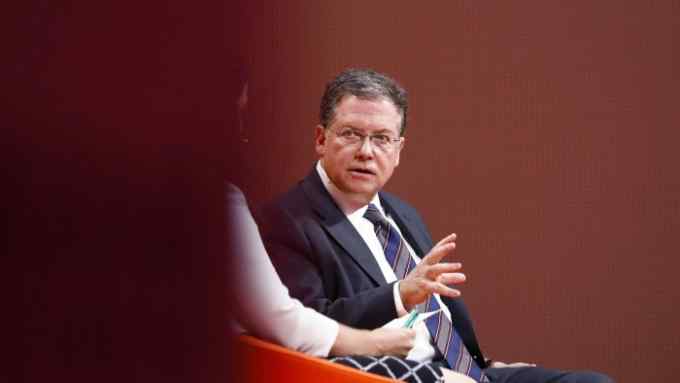Goldman Sachs eyes growth in cash management technology

Roula Khalaf, Editor of the FT, selects her favourite stories in this weekly newsletter.
For more than five years Goldman Sachs has been recasting itself as a technology company as well as a bank, so it is little surprise that Stephen Scherr, chief financial officer, sees tech as core to his professional objectives.
For Mr Scherr, head of Goldman’s fledgling consumer bank until late 2018, there are two main strands: tech that can make the bank more profitable and efficient, and tech that makes his finance office run better.
Technology has been central to some of the Wall Street giant’s biggest initiatives to develop revenue streams beyond the traditional investment banking and trading activities that have fuelled its profits for 150 years or so.
One of those is cash management or transaction banking, the business of holding companies’ deposits and helping them to make payments.
Goldman “wasn’t particularly satisfied” with the cash management services it was getting from other banks, Mr Scherr says, so it decided to build what it calls “a treasury of the future”. This includes digital liquidity management products, self-service account opening and analytics tools including highly automated reports, which Mr Scherr says are cheaper and more accurate than those offered by legacy providers.
A year after it began using the system to manage its own cash, Goldman opened its doors to third-party clients at the start of last year, and its technology-driven transaction banking business has since grown to $27.8bn of deposits. The bank is forecasting significant growth for it in the future.
Technology is also foundational for Goldman’s efforts in consumer banking, spanning everything from Marcus — the online-only bank that Mr Scherr helped launch in late 2016 — and the credit card it launched in partnership with Apple in mid-2019. Goldman has described cards as a key driver of revenue in its growing consumer business.
“We were not burdened by incumbency in transaction banking or the consumer business, so we were able to build out those products in a digital interface for the new and current build,” says Mr Scherr.
“If you look at other banks, some of them are dealing with mainframe engagement that still requires Cobol and the like,” he adds, referring to a more than 60-year-old programming language that still underpins a multitude of functions in the finance industry.

Technology has become a critical differentiator for the bank against Wall Street rivals such as JPMorgan, which is also investing heavily in cutting-edge services and ways to trim the costs of servicing clients.
Devin Ryan, an analyst with JMP Securities, sees “substantial differentiation” between Goldman’s ability to build platforms designed for the future, and peers that he says are “working with either increasingly outdated technology platforms or are attempting to retrofit a legacy system or mobile experience, which often is not a smooth process for firms or their customers”.
Goldman does have legacy technology in its trading business, however, which it has been steadily overhauling.
Customers can now connect directly to Goldman’s system and use desktop apps to trade instead of calling the bank. Swaths of Goldman’s trading business have migrated to electronic platforms, especially in equities, and other types of assets are following.
As for his own office, Mr Scherr says it is crucial for chief financial officers to be well-versed in technological developments because “you can guide the engineers in the firm, and those that are working either in risk or liquidity or capital, to think about ways to deploy technology to make the CFO better equipped to manage the firm”.
One area of focus is monitoring costs. “We are building platforms that help [us to identify] where there are efficiencies to be had in overall expense management,” Mr Scherr says.
Goldman uses an app to manage employees’ travel and entertainment expenses so that Mr Scherr’s office can see those costs in real time, which helps the bank manage compliance.
On future advances for financials more broadly, the blockchain technology that holds data on a mutually accessible ledger has not had “as meaningful an effect as people had forecast”, Mr Scherr says.
However, he adds that he can imagine various circumstances where blockchain could be deployed.
“Look at loans settlement,” he says. “It’s an operational matter that has been long in need of technology uplift and you can imagine blockchain being very useful. The settlement time around the loans and the like, honestly, I don’t think it’s changed in a decade or more.”
He also sees broader applications for artificial intelligence, which Goldman has been deploying across its compliance functions in order to “pick up patterns that might be concerning to us”.
But for Mr Scherr, there is currently no tech magic bullet that could help Goldman run better: “I’m now more focused on where we are deploying the technology [for clients].”


Comments